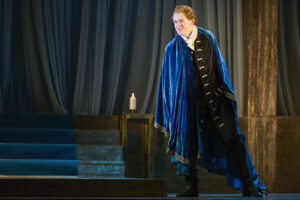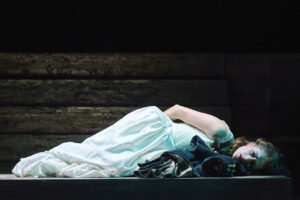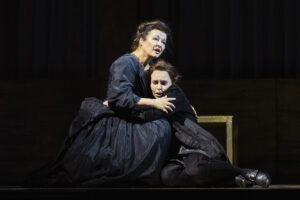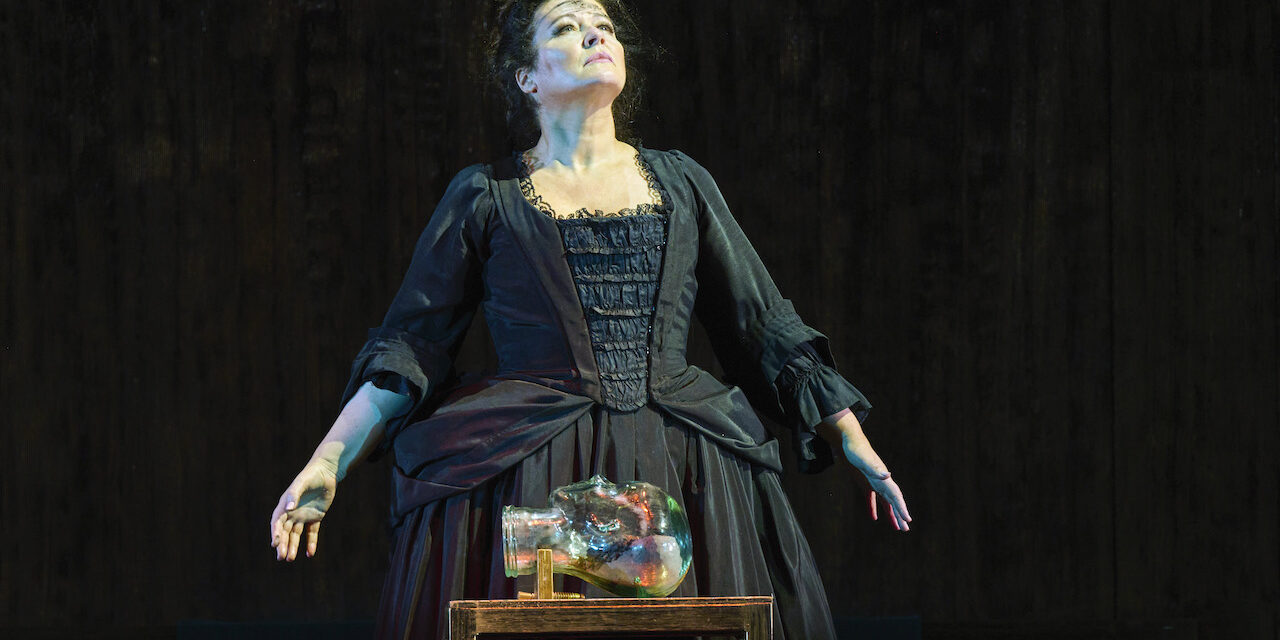
4 May
In a programme note to this English Touring Opera production, the director James Conway explains why he has rejected ‘togas and orientalism’, choosing instead to set his production on the date of its successful first performance at the Haymarket Theatre, London in 1724. In his bold reimagining, the Romans become figures in the Hanoverian court, while the wily Egyptians are tainted by the trappings of Catholicism and intrigue. The transposition works brilliantly, culminating in the scene in which the servant Lidia reveals her true identity as Cleopatra in a powerful performance by Susanna Hurrell. Appearing in a tall alcove at the back of the stage in the deep blue cloak and golden halo of a Renaissance madonna, she seduces both Cesare and the audience with the soaring, plaintive strains of ‘V’adoro pupille.’
One of the difficulties in staging Handel is the lack of stage action. Emotions are declaimed rather than expressed through narrative, and despite a ravishing score and the occasional murder, the operas can feel static to a modern audience. In Giulio Cesare, the title role itself is problematic. Written for a castrato and performed here by counter tenor Francis Gush, the conquering hero is less interesting than those who surround him. The arias should be entrancing, but Gush takes a while to inhabit the part, only reaching his peak in the moment of gentler introspection in ‘Morra, Cesare, morra’ at the end of Act 2.

Of the principal relationships, that between Cleopatra and her brother Tolomeo is more interesting. Nor is there anything gratuitous in the blatant sexuality of their encounters. Initially, Cleopatra is the dominant partner, though Alexander Chance’s complex interpretation leaves us guessing as to whether the childlike Tolomeo is a willing or unwilling victim. His vocal portrayal exhibits a wonderful range of expression, encompassing lust, anger, and quick-fire intrigue. At one point he binds his sister to the ground with ropes. We see and hear him at his most evil, while Hurrell, in the great tradition of operatic sopranos, sings her heart out, never once losing the purity of vocal line, despite lying captive on what looks like a very cold stone floor.

Audiences come to the opera for many reasons but foremost among them is the desire to be moved, to experience those moments of transport sometimes described as ‘the tingle factor’. There are many such moments here and the first arises on the entrance of Sesto, the bereaved son of Pompey. Mezzo soprano Margo Arsane gives a performance of stunning agility and range, moving from the immaturity and awkwardness of youth, tortured by conflicting emotions of horror and determination, into the unavoidable role of vigilante. Sesto is abetted by his desperate mother, Cornelia, sung by Carolyn Dobbin in a voice rich in colour and texture. Hers is an equally affecting interpretation and the anguished family dynamic provides scenes of great depth and power.

All the singers seem to engage more fully as the drama unfolds. So much so that the sudden happiness of the ending and the final duet, ‘Caro! Bella!’ feels a little strange. But such is Handel. This version lasts almost three hours, but the original would have been much longer and might even have been followed by a ballet. Due credit for keeping the action moving here must go to the spirited playing of the Old Street Band which, despite its title, is a full-sized baroque orchestra of period instruments. There were also wonderful solo moments, though too many to name here.
Cordelia Chisholm’s design is spare but effective – a gilded monumental palace with mottled stone steps and arches, their grey-brown tones shifting with the changing moods, enlivened by sudden splashes of peacock blue to suggest the exoticism of a foreign court. The costumes are superb.
The production is not without weaknesses, but it does what opera should do, drawing us into a vividly imagined world, touching our hearts and minds with sublime music.
★★★★☆ Ros Carne 5 May 2023
photo credit Richard Hubert Smith


